GE GSD4000KWW, GSD3300KWW, GSD4000KBB, GSD3340KSA User Manual [nl]

Dishwashers
Safety Instructions . . . . 2–5
Operating Instructions
Care and Cleaning . . . . . . . . . .14
Control Panels. . . . . . . . . . . . . . .8
Control Settings. . . . . . . . . . . 6–7
Dial Cycles . . . . . . . . . . . . . . . . .9
Flashing Display Lights . . . . . . .10
Loading the
Dishwasher Racks. . . . . . . . . . .12
Loading Place Settings . . . . 13-14
Optional Accessories. . . . . . . . .15
Using the Dishwasher . . . . 10, 11
Troubleshooting Tips 16-17
Consumer Support
Consumer Support . . . . . . . . . 19
Warranty . . . . . . . . . . . . . . . . . 18
Write the model and serial numbers here:
Model # ________________
Serial # ________________
You can find them on a label on the tub wall just inside the door.
Owner’s Manual
Standard Tub Dishwashers
49-55091-1 05-16 GE

IMPORTANT SAFETY INFORMATION
5($' $// ,16758&7,216 %()25( 86,1* ³
SAVE THESE INSTRUCTIONS
|
|
For your safety, the information in this manual must be followed to minimize the risk of fire, |
|
WARNING |
|
|
explosion, electric shock, and to prevent property damage, personal injury, or death. |
|
|
|
|
|
|
|

 WARNING WATER HEATER SAFETY
WARNING WATER HEATER SAFETY
Under certain conditions, hydrogen gas may be produced in a water heater that has not been used for two or more weeks.
HYDROGEN GAS IS EXPLOSIVE.
If the hot water has not been used for two or more weeks, prevent the possibility of damage or injury by turning on all hot water faucets and allowing them to run for several minutes. Do this before using any electrical appliance connected to the hot water system. This simple procedure will allow any built-up hydrogen gas to escape. Since the gas is flammable, do not smoke, use an open flame, or use the appliance during this process.

 WARNING PROPER INSTALLATION AND MAINTENANCE
WARNING PROPER INSTALLATION AND MAINTENANCE
This dishwasher must be properly installed and located in accordance with the Installation Instructions before it is used. If you did not receive an Installation Instructions sheet with your dishwasher, you can receive one by visiting our Website at
GEAppliances.com. In Canada, visit www.GEAppliances.ca.
Connect the dishwasher/appliance to a grounded metal, permanent wiring system; or run an equipment-grounding conductor with the circuit conductors and connect to the equipment-grounding terminal or lead of the appliance.
Improper connection of the equipment-grounding conductor can result in a risk of electric shock. Check with a qualified electrician or service representative if you are in doubt whether the appliance is properly grounded.
Dispose of discarded appliances and shipping or packing material properly.
Do not attempt to repair or replace any part of your dishwasher unless it is specifically recommended in this manual. All other servicing should be referred to a qualified technician.
Use only cord kit WX09X70910 or hard-wire to building electrical. Failure to follow this instruction, could result in risk of fire and personal injury.
To minimize the possibility of electric shock, disconnect this appliance from the power supply before attempting any maintenance.
NOTE: Turning the dishwasher off does not disconnect the appliance from the power supply. We recommend having a qualified technician service your appliance.

 WARNING When using your dishwasher, follow basic precautions, including the following:
WARNING When using your dishwasher, follow basic precautions, including the following:
Use this appliance only for its intended purpose as described in this Owner’s Manual.
Use only detergents or wetting agents  recommended for use in a dishwasher
recommended for use in a dishwasher 

 and keep them out of reach of children.
and keep them out of reach of children. 









 Using a detergent that is not specifically
Using a detergent that is not specifically  designed for dishwashers will cause the
designed for dishwashers will cause the
dishwasher to fill with suds.
Locate sharp items so that they are not likely to damage the door seal.
Load sharp knives with the handles up to reduce the risk of cut-type injuries.
Do not wash plastic items unless marked dishwasher safe or the equivalent. For plastic items not so marked, check the manufacturer’s recommendations.
Do not touch the heating element during or immediately after use.
Do not operate your dishwasher unless all enclosure panels are properly in place.
Do not tamper with controls.
Do not abuse, sit on or stand on the door or dish rack of the dishwasher.
To reduce the risk of injury, do not allow children to play with, on or inside this appliance at any time.
Do not store or use combustible materials including gasoline or other flammable liquids or vapors in the vicinity of this or any other appliance.
Small parts, such as rack clips and filter retaining posts, can be a choke hazard to small children if removed from the dishwasher. Keep out of reach of small children.
2

IMPORTANT SAFETY INFORMATION |
|
|
5($' $// ,16758&7,216 %()25( 86,1* ³ |
|
|
SAVE THESE INSTRUCTIONS |
GEAppliances.com |
|
WARNING RISK OF CHILD ENTRAPMENT |
|
|
PROPER DISPOSAL OF THE DISHWASHER |
|
|
Junked or abandoned dishwashers are dangerous…even if they will sit for “just a few days.” |
|
|
If you are getting rid of your dishwasher, please follow the instructions below to help prevent |
|
|
accidents. |
|
|
Do not allow children to play with, on, or inside this or any discarded appliance. |
|
|
'R QRW GLVFDUG D GLVKZDVKHU ZLWKRXW ¿UVW UHPRYLQJ WKH GRRU RI WKH ZDVKLQJ FRPSDUWPHQW |
Door |
|
or remove the latch by removing the two screws from the door latch keeper (as shown). |
latch |
|
|
|
keeper |
CAUTION |
To prevent minor injury and property damage |
|
|
|
|
During or after wash cycle, contents may be hot to the touch. Use care before handling.
Close supervision is necessary if this appliance is used by or near children. Do not allow children to play around the dishwasher when closing the door, closing the upper rack, or while vertically adjusting the upper rack due to the possibility of small fingers being pinched.
Non-Dishware Items: Do not wash items such as electronic air cleaner filters, furnace filters and paint brushes in your dishwasher. Damage to the dishwasher and discoloration or staining of the dishwasher may result.
Load light-weight, plastic items so they do not become
GLVORGJHG DQG GURS WR WKH ERWWRP RI WKH GLVKZDVKHU³ they might come into contact with the heating element and be damaged.

 CAUTION ELECTRICAL REQUIREMENTS
CAUTION ELECTRICAL REQUIREMENTS
This appliance must be supplied with 120V, 60 Hz, and connected to an individual, properly grounded branch circuit, protected by a 15 or 20 amp circuit breaker or time-delay fuse.
If the electric supply provided does not meet the above specifications, it is recommended that a licensed electrician install an approved outlet.
Your dishwasher circuit should not be used for any other appliance while the dishwasher is in operation as the dishwasher requires the full capacity of the circuit.

 NOTICE
NOTICE
If your dishwasher is connected to a wall switch, ensure that the switch is on prior to use.
If you choose to turn the wall switch off between wash cycles, allow 5-10 seconds after turning the switch on before touching Start to allow the control to initialize.
Use only powder, Cascade® All-in-1 ActionPacs™, liquid detergents or rinse agents recommended for use in a dishwasher and keep them out of the reach of children.
Cascade® All-in-1 ActionPacs™ Automatic Dishwashing Detergent, and Cascade® Rinse Aid™ rinse agents have been approved for use in all GE Appliances dishwashers.
READ AND FOLLOW THIS SAFETY INFORMATION CAREFULLY.
SAVE THESE INSTRUCTIONS |
3 |
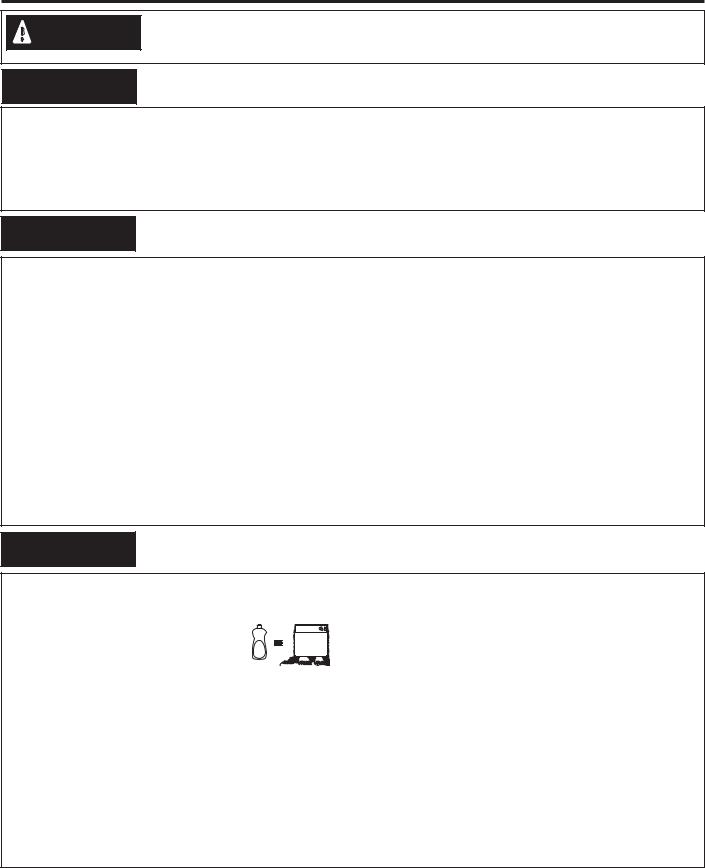
INFORMACIÓN IMPORTANTE DE SEGURIDAD
/($ 72'$6 /$6 ,16758&&,21(6 $17(6 '( 86$5 ³
GUARDE ESTAS INSTRUCCIONES
Para su seguridad, siga las instrucciones de este manual a fin de minimizar riesgos ADVERTENCIA de incendio, explosión, descargas eléctricas, y para evitar daños en su propiedad,
lesiones personales o la muerte.

 ADVERTENCIA SEGURIDAD DEL CALENTADOR DE AGUA
ADVERTENCIA SEGURIDAD DEL CALENTADOR DE AGUA
Bajo ciertas condiciones, se podrá producir gas de hidrógeno en un calentador de agua que no fue usado por dos semanas o más. EL GAS DE HIDRÓGENO ES UN EXPLOSIVO.
Si el agua caliente no se usó durante dos semanas o más, evite la posibilidad de daño o lesión abriendo todos los grifos de agua caliente y permitiendo que el agua corra durante varios minutos. Haga esto antes de usar cualquier artefacto eléctrico que esté conectado al sistema de agua caliente. Este procedimiento simple permitirá el escape de cualquier gas de hidrógeno acumulado. Debido a que el gas es inflamable, no fume, no use una llama abierta ni use el electrodoméstico durante este proceso.

 ADVERTENCIA INSTALACIÓN Y MANTENIMIENTO ADECUADOS
ADVERTENCIA INSTALACIÓN Y MANTENIMIENTO ADECUADOS
Esta lavadora se deberá instalar y ubicar de acuerdo con las Instrucciones de Instalación antes de ser usada. Si no recibió una ficha de Instrucciones de Instalación con su lavavajillas, podrá acceder a una visitando nuestro sitio web en
GEAppliances.com.
Conecte el lavavajillas/ electrodoméstico a un sistema de cableado de metal permanente con conexión a tierra o se debe tender un conducto para la conexión a tierra del equipo con los conductores del circuito y conectado al terminal de tierra del equipo o al conductor de suministro del electrodoméstico.
Una conexión inapropiada del conductor de conexión a tierra del equipo puede provocar riesgos de descargas eléctricas. Consulte a un electricista calificado o personal del servicio técnico si tiene dudas de que el electrodoméstico se encuentre conectado a tierra apropiadamente.
Deshágase de forma correcta de electrodomésticos y materiales de envío o embalajes descargados.
No intente reparar o reemplazar ninguna parte de la cocina, a menos que se lo recomiende específicamente en este manual. Cualquier otra reparación deberá ser realizada por un técnico calificado.
Use sólo el kit de cables WX09X70910 o cables duros para la conexión eléctrica. Si no se siguen estas instrucciones, se pueden producir riesgos de incendio y lesiones personales.
A fin de minimizar la posibilidad de descargas eléctricas, desconecte este electrodoméstico del suministro de corriente antes de intentar cualquier mantenimiento.
NOTA: Apagar el lavavajillas no desconecta el electrodoméstico del suministro de corriente. Le recomendamos que el servicio técnico de su electrodoméstico sea realizado por un técnico calificado.

 ADVERTENCIA Al usar su lavavajillas, siga las precauciones básicas, incluyendo lo siguiente:
ADVERTENCIA Al usar su lavavajillas, siga las precauciones básicas, incluyendo lo siguiente:
Use este electrodoméstico sólo para su propósito original, como se describe en el Manual del Propietario.
Use sólo detergentes o agentes humectantes recomendados para use con un lavavajillas y mantenga los mismos fuera del alcance de los niños. El uso de un detergente que no esté
diseñado específicamente para lavavajillas hará que este último se llene de agua con jabón.
Ubique artículos puntiagudos de modo que no haya posibilidades de daños sobre el sellador de la puertal.
Cargue los cuchillos puntiagudos con los mangos hacia arriba, a fin de reducir el riesgo de lesiones por cortes.
No lave productos de plástico, a menos que contengan una marca de seguridad en lavavajillas o su equivalente. Cuando se trate de productos de plástico que no estén marcados de esta manera, consulte las recomendaciones del fabricante.
No toque el elemento de calefacción durante o inmediatamente después del uso.
No use su lavavajillas a menos que todos los paneles de cercamiento estén correctamente en sus lugares.
No manipule indebidamente los controles.
No abuse, no se siente, no se sostenga ni se pare sobre la puerta o la bandeja del plato del lavavajillas.
A fin de reducir el riesgo de incendios, no permita que los niños jueguen con, sobre o dentro de este electrodoméstico en cualquier momento.
No guarde ni use materiales combustibles, incluyendo gasolina u otros líquidos o vapores inflamables cerca de éste o de otros electrodomésticos.
Las piezas pequeñas, tales como los sujetadores de estantes y los pivotes de retención de filtros, pueden generar riesgos de asfixia en niños pequeños si son retirados del lavavajillas. Mantenga los mismos fuera del alcance de los niños pequeños.
4
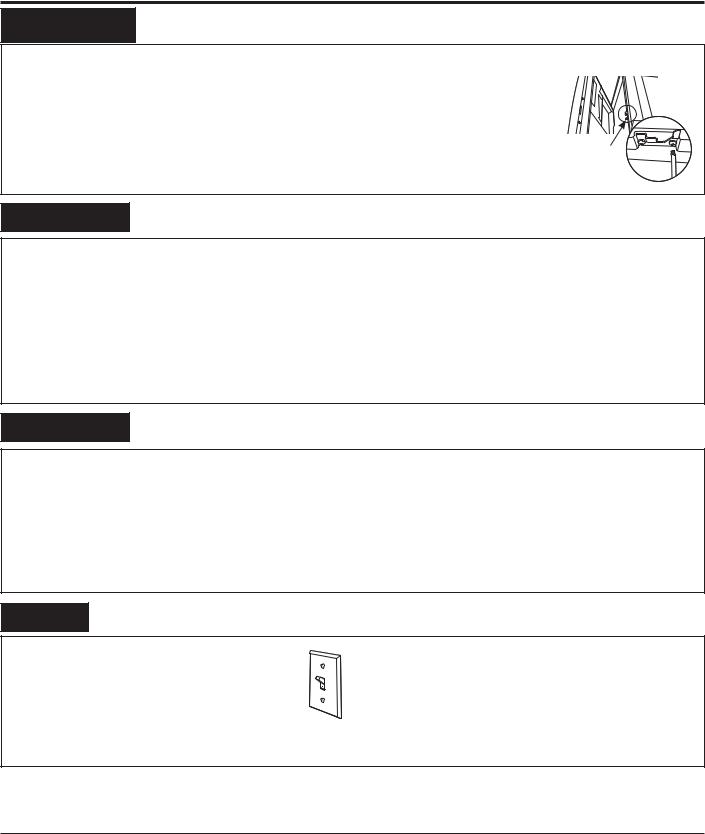
INFORMACIÓN IMPORTANTE DE SEGURIDAD |
|
/($ 72'$6 /$6 ,16758&&,21(6 $17(6 '( 86$5 ³ |
|
GUARDE ESTAS INSTRUCCIONES |
GEAppliances.com |

 ADVERTENCIA RIESGO DE QUE UN NIÑO QUEDE ATRAPADO
ADVERTENCIA RIESGO DE QUE UN NIÑO QUEDE ATRAPADO
FORMA ADECUADA DE DESCARTAR EL LAVAVAJILLAS
Los lavavajillas tirados o abandonados son peligrosos…incluso aunque se conserven por “sólo unos pocos días”. Si se deshará de su lavavajilla, siga las siguientes instrucciones a fin de evitar accidentes.
No permita que los niños jueguen con, en, o dentro de éste o cualquier electrodoméstico que haya descartado.
No se deshaga de un lavavajillas sin primero retirar la puerta del compartimiento de lavado o quitar el pestillo, retirando los dos tornillos de la traba del pestillo de la puerta (como se muestra).
Cierre de puerta keeper

 PRECAUCIÓN A fin de evitar lesiones menores y daños sobre la propiedad
PRECAUCIÓN A fin de evitar lesiones menores y daños sobre la propiedad
Durante o después del ciclo de lavado, es posible que los |
Productos que no sean utensilios: no lave artículos tales |
contenidos estén calientes al tacto. Tenga cuidado antes |
como filtros electrónicos de limpieza con aire, filtros de |
de tomar los mismos. |
horno y brochas de pintura en su lavavajillas. Se podrán |
Se deberá estar especialmente atento si el |
producir daños, descoloración o manchas sobre el |
electrodoméstico es usado por niños o se encuentra |
lavavajillas. |
cerca de los mismos. No permita que los niños jueguen |
Cargue artículos de plástico livianos, de modo que no |
alrededor del lavavajillas cerrar la puerta, cerrar la |
sean desplazados ni caigan al fondo del lavavajillas – es |
bandeja superior, o mientras verticalmente ajustando la |
posible que entren en contacto con el calentador y sean |
rejilla superior debido a la posibilidad de que sus dedos |
dañados. |
pequeños sean presionados. |
|

 PRECAUCIÓN REQUISITOS ELÉCTRICOS
PRECAUCIÓN REQUISITOS ELÉCTRICOS
Este electrodoméstico deberá ser provisto con 120V, 60 Hz, y estar conectado a un circuito individual correctamente conectado a tierra, protegido por un disyuntor o fusible de retardo de 15 o 20 amp.
Si el suministro de corriente provisto no cumple con las especificaciones anteriores, se recomienda que un electricista matriculado instale un tomacorriente aprobado.
Su circuito del lavavajillas no debería ser usado para ningún otro electrodoméstico mientras el lavavajillas está funcionando, ya que éste requiere toda la capacidad del circuito.

 AVISO
AVISO
Si el lavavajillas está conectado a un tomacorriente
de pared, asegúrese de que el interruptor esté encendido antes del uso.
Si decide apagar el interruptor entre ciclos de lavado, espere entre 5 y 10 segundos luego de
encender el interruptor antes de presionar Start (Iniciar) para permitir que el control se inicie.
Use sólo polvo, Cascade® All-in-1 ActionPacs™, detergentes líquidos o agentes de enjuague recomendados para uso con un lavavajillas y mantenga los mismos fuera del alcance de los niños. El Detergente para Lavavajillas Automáticos
Cascade® All-in-1 ActionPacs™, y los agentes de enjuagues
Cascade ® Rinse Aid™ fueron aprobados para su uso en todos los lavavajillas de GE Appliances.
LEA Y SIGA ESTA INFORMACIÓN DE SEGURIDAD CUIDADOSAMENTE.
GUARDE ESTAS INSTRUCCIONES
5

About the dishwasher control panel
Control Settings
nCycles
An indicator light above the selected pad will be ON to indicate which CYCLE has been selected, on some models.
POTS & PANS/ For heavily soiled dishes or cookware with dried-on or baked-on soils. Everyday dishes may be included. HEAVY WASH This cycle will not remove burned-on foods.
(on some models)
NORMAL/ This cycle is meant for daily, regular, or typical use to completely wash a full load of normally soiled NORMAL WASH dishes and is designed to conserve both water and energy.
SHORT WASH For quickly washing loads of everyday dishes with medium soils that have not dried on, such as loads (on some models) consisting mostly of glasses.
WATER SAVER For dishes with light soils.
LIGHT WASH
(on some models)
RINSE ONLY For rinsing partial loads that will be washed later. Do not use detergent.
DRYING For warming clean dishes and serving plates. This cycle will take approximately 30 minutes.
PLATE WARMER
HOT PREWASH Preheats wash water to the correct temperature.
HOT START
CHINA CRYSTAL For lightly soiled china and crystal.
(on some models)
oOptionsAn indicator light above the selected pad will be ON to indicate which OPTION has been selected, on some models.
HI TEMP Turns on the heater in all final rinse cycles to help prevent spotting on dishware. This option may be RINSE turned ON or OFF during the wash cycle.
(on some models)
HI TEMP Energizes the heater to boost water temperature in prewash and main wash fill cycles. Recommended WASH for use with heavily soiled dishes. Option may be turned ON or OFF during the wash cycle.
HEATED DRY Shuts off the drying heat option. Dishes air dry naturally and energy is saved. Open the dishwasher door OFF to speed drying.
HEATED DRY Turns the heater on for fast drying. This cycle will extend the time to your wash cycle by 30 minutes. ON DO NOT use with RINSE ONLY cycle.
LOCK When the LOCK pad is touched twice within 3 seconds, all pads become inoperative. You can lock the controls to
(electronic models prevent any selections from being made. Or you can lock the controls after you have started a cycle or selected only) DELAY START so the cycle or DELAY START is not interrupted.
Children cannot accidentally start dishwasher by touching pads with this option selected.
To unlock the dishwasher after it has been locked, touch the LOCK pad twice within 3 seconds. The light above the LOCK pad will turn off.
DELAY HOURS Delays the start of a wash cycle for up to 8 hours.
(on some models)
RESET Touch RESET to cancel options.
(timer models)
START/RESET Touch START/RESET one time to start dishwasher cycle. Touch START/RESET a second time to pump out (electronic models) and then turn off the dishwasher. Do not touch START/RESET more than one time unless you intend to end the cycle.
6

GEAppliances.com
Control Settings
Cycle Chart
Models |
|
Cycle |
Water Usage (gal.) |
Cycle Time (min.) |
|
||||
|
|
|
|
|
Timer Models |
|
Hot Start Option1 |
2.5 |
10 |
|
|
Heavy Wash |
4.9 - 7.0 |
120 |
|
|
Pots & Pans |
6.0 - 7.0 |
118 |
|
|
Normal Wash* |
3.5 - 5.0 |
106 |
|
|
Rinse Only |
2.2 |
58 |
|
|
Plate Warmer/Drying |
0.0 |
45 |
|
|
|
|
|
Electronic Models |
|
Pots & Pans |
8.8 |
121 |
|
|
Heavy Wash |
7.5 |
115 |
|
|
Normal Wash |
3.5 |
109 |
|
|
China/Crystal |
6.3 |
87 |
|
|
Rinse Only |
1.3 |
5 |
|
|
|
|
|
|
|
|
|
|
1Hot Start Option adds water amount and cycle time shown when selected. *Normal Wash button (on some models) should be pushed to run this cycle.
NOTE: Not all models have every cycle listed.
7
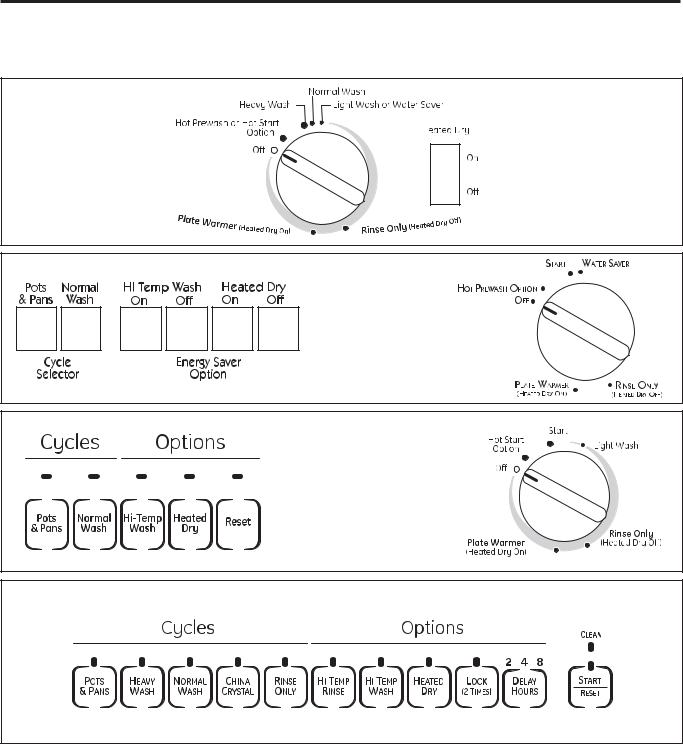
About the dishwasher control panel
You can locate your model number on the left tub wall just inside the door. Throughout this manual, features and appearance may vary from your model.
Please match the control panel for your unit to a similar control panel below.
8

Operation of models with cycle dial GEAppliances.com
Rinse Only
For rinsing partial loads that will be washed later. Do not use detergent.
|
Make sure HEATED DRY is not selected. |
|
Slowly turn the Dial to RINSE ONLY. |
1 |
3 |
||
|
|
||
2 |
Be sure the door is unlatched. |
4 |
Latch the door to start the cycle. |
|
|
Plate Warmer or Drying
For warming clean dishes and serving plates. This cycle will take approximately 39 minutes.
|
|
|
Slowly turn the Dial to PLATE WARMER or |
|
|
Load clean dishware to be warmed. |
4 |
||
1 |
||||
|
||||
|
|
|
DRYING. |
|
|
Select HEATED DRY ON. |
5 |
Latch the door to start the cycle. |
|
2 |
||||
|
||||
|
Be sure the door is unlatched. |
|
|
|
3 |
|
|
Hot Start or Hot Prestart Option
Preheats wash water.
1 Select the HOT START or HOT PRESTART cycle and any other option on the push button pad.
2 Be sure the door is unlatched.
3 Slowly turn the Dial to HOT START or
HOT PRESTART.
4 Latch the door to start the cycle.
Short Wash or Light Wash or Water Saver
For quickly washing loads of everyday dishes with light to medium soils that have not dried on.
1 Be sure the door is unlatched.
2 Slowly turn the Dial to SHORT WASH, LIGHT WASH or WATER SAVER.
3 Latch the door to start the cycle.
Start (Models with a Dial)
Slowly turn the Dial to the START or ON position, or the selected cycle. Don’t turn it past the START, ON or cycle position; you could accidentally miss a prewash.
There is a time delay between start-up and water fill so you will not hear any wash action right away.
Latch the door to begin the cycle.
9

Operation of electronic models (model GSD4000 Only)
Using the Dishwasher Door
1 The door must be closed and locked into place to select a LOAD SELECTION or an OPTION.
2 If the door is opened during a cycle and left open, the dishwasher will beep once every 30 seconds until the door is closed and latched into place.
Start
Close and latch the door. Touch the START/RESET pad to begin the cycle. Water fill begins and approximately 60 seconds later the wash action begins.
NOTE: The dishwasher remembers your last cycle so you don’t have to reprogram each time. When the dishwasher is loaded and the door latch is in the locked position, the control panel lights will be ON and display the last settings you selected.
If you don’t want to change any of the settings, simply touch the START/RESET pad to begin the cycle.
Also, if a power failure occurs, NORMAL and HEATED DRY will automatically be programmed. Make any new selections and touch the START/RESET pad to begin the cycle.
Clean
This light is illuminated when a wash cycle is complete. The light will stay ON until the door is opened.
Flashing Display Lights
Lights |
What It Means |
What To Do |
|
|
|
|
This is normal. |
Allow the dishwasher to drain and reset before you start a new |
|
||
|
The START/RESET pad |
wash cycle. |
START |
has been pressed. |
|
|
|
|
RESET |
|
|
|
|
|
CLEAN |
Control Error |
Press the START/RESET pad to turn off the beeper. If the CLEAN |
|
light continues to flash, call for service. |
PLUS A
BEEPING
SOUND
|
Control Error |
Press the START/RESET pad to turn off the beeper and the |
|
||
|
|
dishwasher will attempt to reset. Restart the wash cycle. |
|
|
If this error continues, turn off the power to the dishwasher at |
|
|
the circuit breaker for 30 seconds. Try the dishwasher again. |
|
|
If the error is still present, call for service. |
|
|
|
PLUS A
BEEPING
SOUND
10

Using the dishwasher |
GEAppliances.com |
|
|
Check the Water Temperature
The entering water must be at least 120°F and not more than 150°F, for effective cleaning and to
prevent dish damage. Check the water temperature with a candy or meat thermometer. Turn on the hot water faucet nearest the dishwasher, place
the thermometer in a glass and let the water
run continuously into the glass until the temperature stops rising.
Adjust the maximum/minimum temperature of the water heater if necessary to deliver water at the proper temperature.
Use a Rinse Agent such as Cascade® Rinse Aid™
Rinse agents, such as Cascade® Rinse Aid™ are designed for great drying action and to protect against spots and film build-up on your dishes, glasses, flatware, cookware, and plastic.
Filling the Dispenser
Fill the rinse agent dispenser until it reaches the bottom of lip inside the opening. Replace cap.
To check if rinse agent is needed, remove the cap and
look into the dispenser.
A full dispenser should last about one month. If the rinse agent spills, wipe up the excess.
Proper Use of Detergent
Use only detergent specifically made for use in dishwashers. Cascade® Automatic Dishwashing Detergents have been approved for use in all GE Appliances dishwashers. Keep your detergent fresh and dry. Don’t put powder detergent into the dispenser until you’re ready to wash dishes.
The amount of detergent to use depends on whether your water is hard or soft. With hard water, you need extra detergent. With soft water, you need less detergent.
Protect your dishes and dishwasher by contacting your water department and asking how hard your water is. Twelve or more grains is extremely hard water. A water softener is recommended. Without it, lime can build up in the water valve, which could stick while open and cause flooding. Too much detergent with soft water can cause a permanent cloudiness of glassware, called etching.
Use the information in the table below as a guideline to determine the amount of automatic dishwasher detergent to place in the dispenser.
Number |
|
of Grains |
Detergent Cups to Fill |
|
|
Less than 4 |
Fill to 1/3 of main cup |
|
|
4 to 8 |
Fill to 2/3 of main cup |
|
|
8 to 12 |
Fill main cup |
|
|
Greater than 12 |
Fill main cup and open cup |
You’ll find two detergent dispensers on the inside door of your dishwasher. All wash cycles require detergent in the main cup. When using automatic dishwashing detergent tabs, such as Cascade® Platinum Pacs, simply place one tab in the main cup and close.
Be sure the Dial is OFF before adding detergent. Otherwise, the detergent cup will not close and latch properly. Add detergent then close the main cup.
Open cup
Main cup
NOTE: To open detergent cup after it has been closed, simply turn the detergent cup handle counterclockwise until it releases. A snapping sound may be heard.
DO NOT USE HAND DISH DETERGENT NOTE: Using a detergent that is not specifically designed for dishwashers will cause the dishwasher to fill with suds. During operation, these suds will spill out of the dishwasher vents, covering the kitchen floor and making the floor wet.
Because so many detergent containers look alike, store the dishwasher detergent in a separate space from
all other cleaners. Show anyone who may use the dishwasher the correct detergent and where it is stored.
While there will be no lasting damage to the |
|
dishwasher, your dishes will not get clean using a |
|
dishwashing detergent that is not formulated |
11 |
to work with dishwashers. |
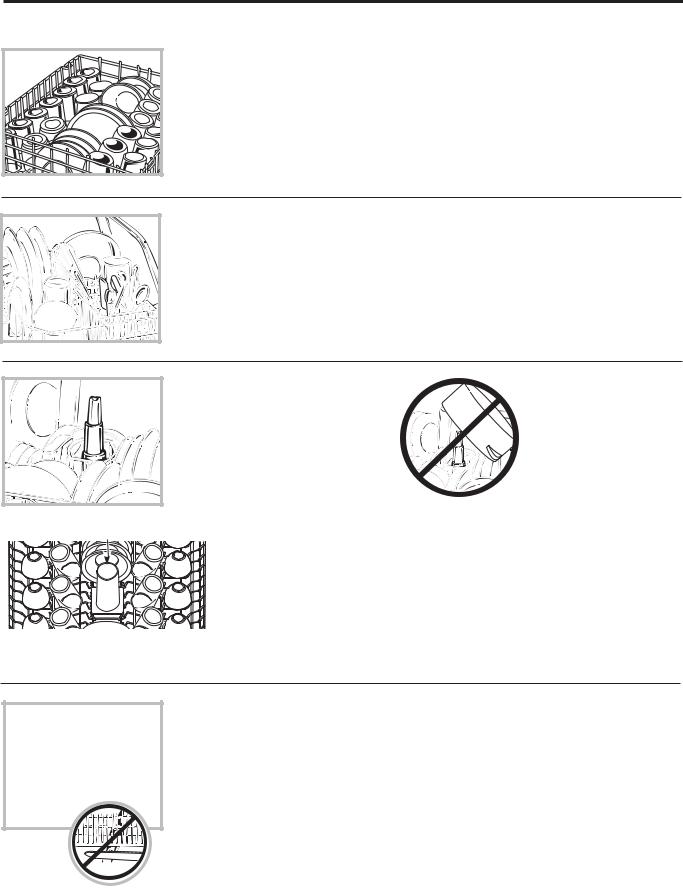
Loading the dishwasher racks
For best dishwashing results, follow these loading guidelines. Features and appearance of racks and silverware baskets may vary from your model.
Upper Rack |
|
|
The upper rack is for glasses, cups and |
Secure larger dishwasher-safe plastics over |
|
saucers. Cups and glasses fit best along |
two fingers when possible. |
|
the sides. This is also a secure place for |
Make sure small plastic items are secure so |
|
dishwasher-safe plastics. The upper rack is |
||
they can’t fall onto the heating element. |
||
good for all kinds of odd-shaped utensils. |
||
|
||
Saucepans, mixing bowls and other items |
|
|
should be placed face down. |
|
Lower Rack
When loading the lower rack, do not load large platters or trays in the front right corner. They may prevent detergent from circulating during the wash cycle.
The lower rack is best used for plates, saucers and cookware. Large items such as broiler pans and racks should go along the sides. Load platters, pots and bowls along the sides, in corners or in the back. The soiled side of items should face the center of the rack.
Wash Tower
Keep the center area clear in the lower rack.
The wash tower rises through the center of the lower rack during the wash and rinse portions of the cycle.
Tower
Don’t block the upper rack
wash tower.
Do not cover upper rack tower (not present on all models)
Don’t block the wash tower or load tall things next to it.
Be sure items don’t fall through rack and block rotation of the spray arm.
Also, be careful not to let a portion of an item such as a pot or dish handle extend through the bottom rack. This could block the wash arm and cause poor washing results.
Silverware Basket
Put flatware in the removable basket with fork and knife handles up to protect your hands. Place spoons in the basket with handles down. Mix knives, forks and spoons so they don’t nest together.
Distribute evenly. Small plastic items, such as measuring spoons and lids from small containers, should go in the bottom of the silverware basket with silverware on top.
DON’T LET ANY ITEM EXTEND THROUGH BOTTOM OF SILVERWARE BASKET AND RACK, TO ENSURE PROPER FUNCTION OF SPRAY ARM.
12
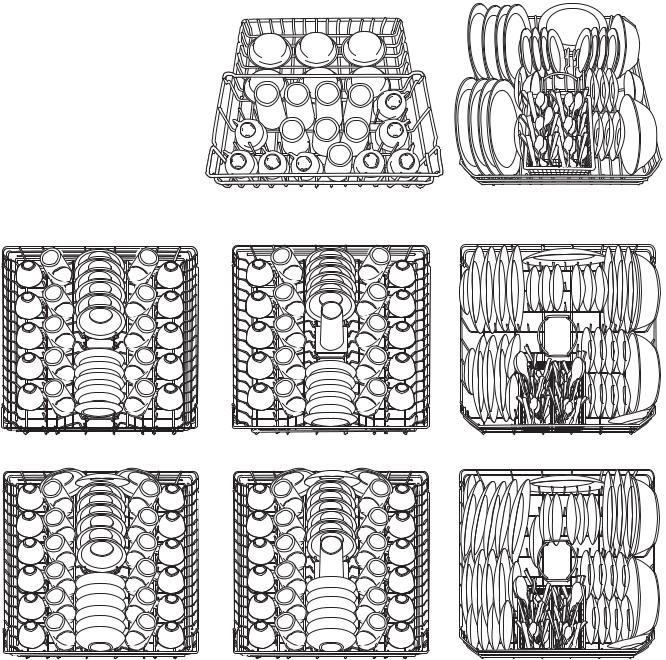
Loading place settings… |
GEAppliances.com |
Follow these guidelines for loading 10 place settings. Features and appearance of racks and silverware baskets may vary from your model.
8SSHU 5DFN³ SODFH VHWWLQJV |
/RZHU 5DFN³ SODFH VHWWLQJV |
Undersink Models |
Undersink Models |
8SSHU 5DFN³ SODFH VHWWLQJV 8SSHU 5DFN³ SODFH VHWWLQJV /RZHU 5DFN³ SODFH VHWWLQJV
8SSHU 5DFN³ SODFH VHWWLQJV 8SSHU 5DFN³ SODFH VHWWLQJV /RZHU 5DFN³ SODFH VHWWLQJV
13

Loading place settings… |
GEAppliances.com |
|||
|
Forget to Add a Dish? |
|
||
|
A forgotten dish can be added any time before the main wash. |
|
||
|
|
1 |
Push the door latch to the left. |
|
|
|
|
Once the water calms, open the door. Steam may rise out of the dishwasher. |
|
|
|
2 |
|
|
|
|
|
Add forgotten dish. |
|
|
|
3 |
|
|
|
|
|
Close the door and push the latch to the far right. |
|
|
|
4 |
|
|
|
Tips for Loading and Good Wash Performance |
|
||
Don’t block the lower rack wash tower.
Don’t let items fall through rack and block spray arms.
14
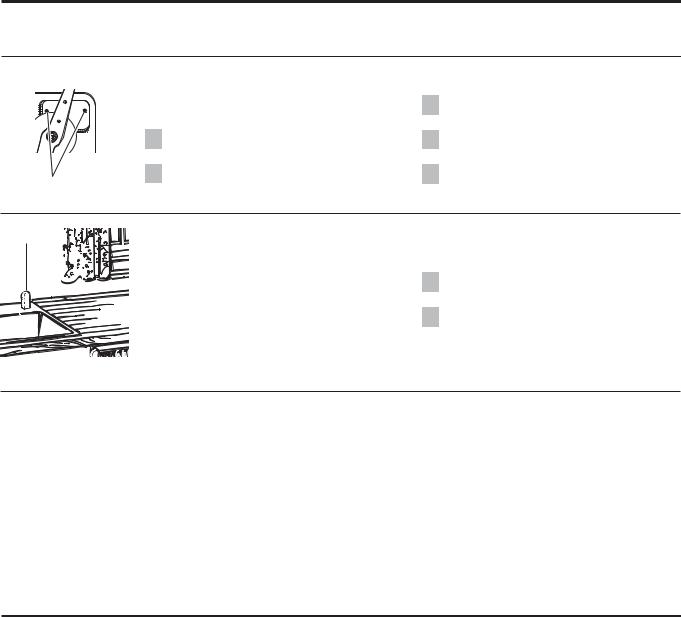
Caring for the dishwasher |
GEAppliances.com |
|
To clean the control panel, use a lightly dampened cloth, then dry thoroughly. To clean the exterior, use a good appliance polish. Never use sharp objects, scouring pads or harsh cleaners on any part of the dishwasher.
Protect Against Freezing
If your dishwasher is left in an unheated place during the winter, ask a service technician to:
1 Cut off electrical power to the dishwasher. Remove fuses or trip circuit breaker.
|
2 Turn off the water supply and disconnect the |
Sump cover screws |
water inlet line from the water valve. |
3 Drain water from the inlet line and water valve. (Use a pan to catch the water.)
4 Reconnect the water inlet line to the water valve.
5 Remove the plastic sump cover in the tub bottom and use a sponge to soak up water in the rubber boot.
Air gap |
Does Your Dishwasher Have an Air Gap? |
An air gap protects your dishwasher against water backing up into it if a drain clogs.
The air gap is not a part of the dishwasher. It is not covered by your warranty. Not all
plumbing codes require air gaps, so you may not have one.
The air gap is easy to clean.
1 Turn off the dishwasher and lift off the chrome cover.
2 Unscrew the plastic cap and clean with a toothpick.
Check the air gap any time your dishwasher isn’t draining well.
Stainless Steel Panels
For cleaning rust and tarnish, cleaners with oxalic acid such as Bar Keepers Friend Soft Cleanser™ will remove rust, tarnish and small blemishes. Use only a liquid cleanser free of grit and rub in the direction of the brush lines with a damp soft sponge. Do not use appliance wax or polish on the stainless steel.
For other blemishes and marks, use Stainless Steel Magic or a similar product using a clean soft cloth. Do not use appliance wax, polish, bleach or products containing chlorine on Stainless Steel. You can order Stainless Steel Magic # WX10X29 through GE Appliances Parts by calling 877.959.8688. In Canada, call 1.800.661.1616.
Optional accessories
Non-wood countertop bracket kit³This is for installations which have non-wood countertops and includes side-mounting brackets and instructions for securing the dishawasher:
GPF65
Consult your GE Appliance dealer to get the correct kit for your model.
These accessories are available at extra cost from GE Appliances. Call 877.959.8688 to order, or see your authorized GE Appliances dealer. Visa, MasterCard or Discover cards are accepted. Specify accessory number when ordering.
15
